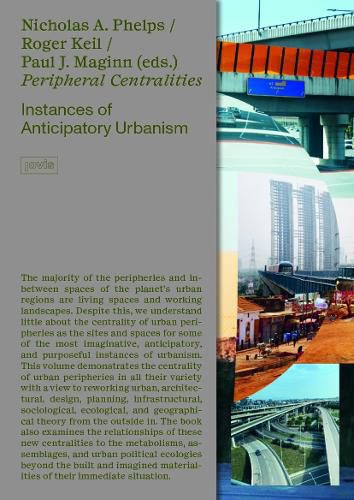Readings Newsletter
Become a Readings Member to make your shopping experience even easier.
Sign in or sign up for free!
You’re not far away from qualifying for FREE standard shipping within Australia
You’ve qualified for FREE standard shipping within Australia
The cart is loading…






The majority of the peripheries and in-between spaces of the planet's urban regions are living spaces and working landscapes. Despite this, we understand little about the centrality of urban peripheries as the sites and spaces for some of the most imaginative, anticipatory, and purposeful instances of urbanism. This volume demonstrates the centrality of urban peripheries in all their variety with a view to reworking urban, architectural, design, planning, infrastructural, sociological, ecological, and geographical theory from the outside in. The book also examines the relationships of these new centralities to the metabolisms, assemblages, and urban political ecologies that exist beyond the built and imagined materialities of their immediate situation.
Peripheral Centralities challenges the premise that the city and its downtown are the primary urban centers. A must read for any urbanist.
-Bernadette Hanlon, Associate Professor of City and Regional Planning, Ohio State University
This groundbreaking volume presents a novel epistemology of the urban. Peripheral Centralities is a call to action for the next generation of scholars as it brings about new imaginaries and provokes courageous and innovative thinking.
-Camilla Perrone, Associate Professor, Department of Architecture, Urban and Regional Planning Unit, University of Florence
Peripheral Centralities is rich in international examples, stylish and accessible. It is an original, imaginative exploration of the centrality of suburbanization to contemporary urban theory and built environment practice.
-Fulong Wu, Bartlett Professor of Planning, University College London
Features pioneering writing and illustrations on designed centralities in urban peripheries
Presents a range of international examples covering most continents
Offers novel theoretical interpretations from across the built environment disciplines
$9.00 standard shipping within Australia
FREE standard shipping within Australia for orders over $100.00
Express & International shipping calculated at checkout
Stock availability can be subject to change without notice. We recommend calling the shop or contacting our online team to check availability of low stock items. Please see our Shopping Online page for more details.
The majority of the peripheries and in-between spaces of the planet's urban regions are living spaces and working landscapes. Despite this, we understand little about the centrality of urban peripheries as the sites and spaces for some of the most imaginative, anticipatory, and purposeful instances of urbanism. This volume demonstrates the centrality of urban peripheries in all their variety with a view to reworking urban, architectural, design, planning, infrastructural, sociological, ecological, and geographical theory from the outside in. The book also examines the relationships of these new centralities to the metabolisms, assemblages, and urban political ecologies that exist beyond the built and imagined materialities of their immediate situation.
Peripheral Centralities challenges the premise that the city and its downtown are the primary urban centers. A must read for any urbanist.
-Bernadette Hanlon, Associate Professor of City and Regional Planning, Ohio State University
This groundbreaking volume presents a novel epistemology of the urban. Peripheral Centralities is a call to action for the next generation of scholars as it brings about new imaginaries and provokes courageous and innovative thinking.
-Camilla Perrone, Associate Professor, Department of Architecture, Urban and Regional Planning Unit, University of Florence
Peripheral Centralities is rich in international examples, stylish and accessible. It is an original, imaginative exploration of the centrality of suburbanization to contemporary urban theory and built environment practice.
-Fulong Wu, Bartlett Professor of Planning, University College London
Features pioneering writing and illustrations on designed centralities in urban peripheries
Presents a range of international examples covering most continents
Offers novel theoretical interpretations from across the built environment disciplines